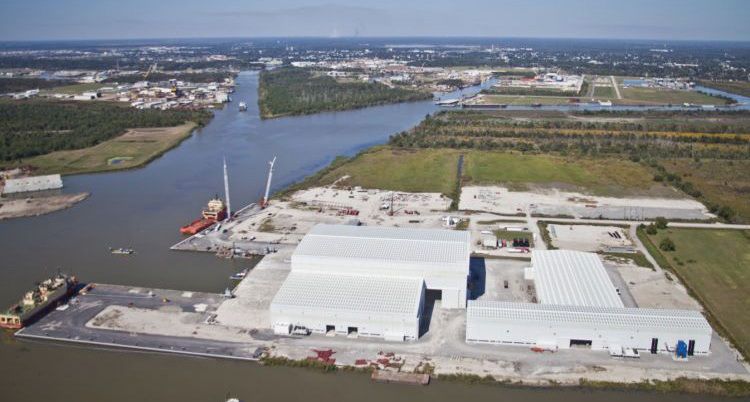
UPDATED: Injured football player ‘responding’, but still in critical condition
September 30, 2015
Alfreda Richoux
October 6, 2015The continued need for a channel cleared to its maximum depth from the Gulf of Mexico to Houma is essential, local industry voices have long maintained.
So now, as they continue waiting for greater attention from federal officials, local industry leaders are exploring ways to do the job – or a portion of it – themselves.
The expressed need for maintenance dredging is one of several marine industry wish-list items but likely the more attainable for now, one way or the other. The real prize that is sought would be the dredging of the Houma Navigation Canal to a depth of at least 15 feet rather than the current 12 feet. But that literally requires an act of Congress. Gulf Island Fabrication has already left Terrebonne Parish; government and industry leaders are concerned that more may follow.
That leaves a parish for which oilfield service and related shipbuilding are essential economic drivers, officials say, essentially without a deep-water port.
“We have already seen how the lack of sufficient channel depth caused Gulf Island to acquire another facility in Texas that had sufficient depth to construct and transport large oilfield structures,” said Terrebonne Parish President Michel Claudet, when asked about the importance of dredging. “Channel depth has already caused us to lose jobs and economic activity in this area.”
Port of Terrebonne executive director David Rabalais has been preaching the gospel of channel dredging non-stop. While the Port of Terrebonne’s recently adjusted its national rank in terms of how busy individual ports are – essential for being placed on the Army Corps of Engineers dredging list in a more timely manner – the priority for its aquatic lifeline, the HNC, is still low compared to other locations.
“If a two-foot diameter tree fell on every road in Terrebonne Parish, the businesses in this parish would not survive because no one would be able to drive across a two foot diameter tree,” Rabalais said, in a message to his board members that he shared with The Times. “That’s exactly what is happening to our fabrication and repair businesses in this parish.”
The difference, Rabalais drily notes, is that while crews would be scrambling to clear the trees, the same is not true for the HNC, despite the potentially disastrous consequences.
Talks are ongoing between the port and federal officials, specifically with the corps. Any remedy local industry and government comes up with before the corps finally approves a meaningful dredging project will need permits from that entity.
“We are talking about building an apparatus of some sort, and we need to have the corps in agreement about the best way to do it,” Rabalais told The Times.
One of the solutions, presuming a local marine company will assist, would be a device that could be pulled with a barge that will remove debris on the bottom and push it to the sides, much as what is used for clearing areas for pipeline.
But Rabalais said it’s still too early to discuss specifics.
“The idea is to clear a path wide enough and deep enough for a vessel to safely navigate,” he said.
Some dredging does get done, in the Houma Nav and other important waterways. But it is not nearly enough, Rabalais maintains.
“Congress does not allocate enough funds to maintain the authorized channel depths in the New Orleans District,” he said. “It’s that simple. Congress does not recognize that it’s an investment that the returns more than outweigh. All we need in typical years is $3.5 million. The New Orleans District’s allocation varies from year to year but ranges from $75 to $100 million.”
Rabalais and other officials stress that the need for maintenance dredging, or the currently impossible dream of channel deepening, is not a lagniappe that will benefit some businesses to do better than they currently are.
Rather, the way they explain it, the matter involves survival of the industry.
“Now more than ever, our local fabrication and repair industry needs our help. With oil at $40 to $50 a barrel the shelf work is dead,” Rabalais said. “The majority of boats that need repair today are the deep draft vessels.
All working vessels are required to have a top-side inspection ever year, and a bottom survey every two years. And that poses a problem with a shallow channel, he said.
“The majority of boats requiring inspections today are deep draft vessels because they are the only vessels working,” Rabalais said.
A collateral problem with an obstructed channel, Rabalais said, is that it threatens full realization of the benefits from various road improvements, he said.
“In an effort to utilize the billions of dollars of local, state and federal tax funded infrastructure implemented to assist local industry operate businesses dependent on the HNC to create economic development, the Terrebonne Port Commission needs to apply for a maintenance permit,” he said. The maintenance done by the Port itself would maintain the depth from Mile Marker zero to Mile Marker 12.
“Although dredging is a very expensive option for industry to bear, this opportunity will be the only option industry will have due to the lack of federal funds,” the director said. “I am hoping we can get some assistance from the state. This is a longer term project for consideration.”
Rabalais continues working toward a better way of measuring the cargo that travels through every waterway in Terrebonne Parish, which is its statutory jurisdiction.
“The port has increased Terrebonne’s cargo tonnage ranking within the last two years from 150 out of 150 to 86th in the country,” Rabalais said. “But even with this rank the USACE still does not receive the necessary funds from Congress to allocate $3.5 million a year to the HNC. The HNC is the main highway for vessel traffic to the US Gulf of Mexico and the rest of the world. “









